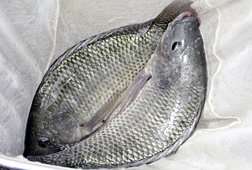ARS scientists developed and evaluated tilapia that are resistant to bacteria that cause streptococcosis. Credit: Agricultural Research Service
The United States annually imports nearly $1 billion worth of tilapia while producing another 30 million pounds ourselves. This makes tilapia the U.S.'s fourth most consumed fish. Worldwide, farmed-raised tilapia is nearly an $8 billion yearly industry. Those same tilapia farmers lose about $1 billion annually due to streptococcosis. The main culprits are two bacteria, Streptococcus agalactiae and S. iniae.
Agricultural Research Service (ARS) scientists and industry partners have developed tilapia that are resistant to both S. iniae and S. agalactiae.
Strategies to combat streptococcosis are effective, but not without drawbacks. Vaccines and antibiotics are expensive, and using antibiotics raises concerns about antimicrobial resistance.
Benjamin LaFrentz and Craig Shoemaker, molecular biologists at the ARS Aquatic Animal Health Research Unit in Auburn, Alabama, showed that selective breeding for disease resistance is a promising alternative.
Working with Akvaforsk Genetics, a selective breeding company specializing in aquaculture species, and Spring Genetics, a tilapia breeding and distribution company, LaFrentz and Shoemaker evaluated tilapia for resistance to S. iniae and S. agalactiae. They found that crosses between the best performing fish were more resistant to the bacteria than other tilapia.
This milestone research paves the way for developing more lines of tilapia with resistance to other pathogens. Spring Genetics data shows that the improved tilapia lines will save an average-size farm nearly $635,000 a year annually.
The studies, published in Aquaculture, will help fish farmers produce better fish and use fewer antibiotics.
Provided by Agricultural Research Service























